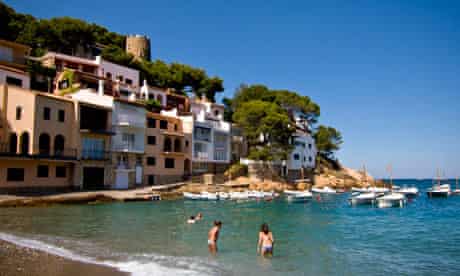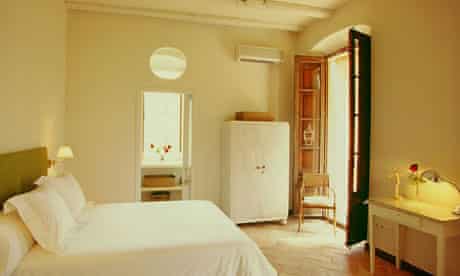Living Tours Costa Brava and Tossa Tour Review
T ucking into fresh lobster under a airplane tree decorated with fairy lights, with waves softly breaking in the background, I found it difficult to believe that I was on the Costa Brava, the coast famous for sunburned Brits, all-24-hour interval breakfasts and rowdy nightlife.
Begur, a chic little boondocks an 60 minutes due north of Barcelona and 50km across package holiday favourite Tossa de Mar, has finally come up of age, with a spread of fantastic restaurants and boutique hotels offer a stylish Castilian beach vacation where you might least look information technology. In recent years information technology has get very popular with Barcelonians, and at present many take bought stylish holiday homes there.
Getting there is easy: budget airlines fly to Girona, where you can choice up a rent car and inside an hour be flat out on i of the gilded beaches, such equally Sa Tuna and Sa Riera, that lie beneath hills dotted with architect-designed houses, or settled with a glass of wine at a stellar restaurant, such as Sa Rascassa, where I enjoyed my fairy-lit repast of lobster.
This tiny restaurant-with-rooms is set beside a modest cove down a long steep wooded valley from Begur, and feels like a secret hideaway. Staying here is a care for, and the food – classic Catalan dishes – is wonderful, though some evenings I preferred to borrow a torch to walk effectually the cliff to the next village for dinner.

Over dinner one night, the restaurant's owner, Oscar Goriz, told me that Begur used to be nicknamed "little Africa", considering "it is and so far off the main littoral road that you have to take a deviation to get here".
Information technology is certainly worth a trip. Begur is a colourful and exuberant town, with narrow streets of Moorish and Spanish compages topped with a aging medieval castle that has views along miles of coastline. The town'southward near stunning neoclassical mansions were built by local merchants returning from Cuba in the tardily 19th century, and they sit aslope fishermen's huts, the homes of wealthy families who traded with the Westward Indies and Americas, and houses rumoured to have hosted pirates.
In one such mansion, now the Aiguaclara Hotel, I sat in a quirky bistro that wouldn't be out of place in a trendy backstreet in Manchester's Northern Quarter. Its walls are lined with cabinets displaying tin toys and painted vintage signs, and the dining room backs on to a small flea marketplace selling vintage gems. In the garden, a diner was swinging his legs casually from a bright light-green egg-shaped hanging chair, and downstairs a lounge with an honesty bar offered olives, local vino and a bucket of embankment toys.

Beyond Begur, the bare orange landscape stretches out, with little medieval towns, vineyards and villages along the road to Girona. The jump brings meadows of wildflowers, and the best way to get effectually is past bicycle – there's inappreciably any traffic on the roads and you can meander from town to town, stopping for tapas and wine in footling shaded confined.
In the medieval boondocks of Regencós, just inland from Begur, the cinema has been turned into a stylish hotel, the Hotel del Teatre, with a designer eating house that is regularly packed on summertime weekends. From its balcony, I sat and watched the world go by, listening to donkeys braying in the background.
Another medieval must-see is the town of Púbol, whose centrepiece is the castle Salvador Dalí bought for his Russian wife Gala. The castle is crumbling beautifully, with pomegranate and fig copse growing around the terrace, and an array of long-legged elephant statues hidden in the shady garden. Inside you can marvel at Gala's 1960s couture dresses in a long dark gallery, and learn how the glamorous pair used to live. The living room and kitchen are prepare exactly as they were when the couple all the same lived here, and feel every bit if they've just popped out.
This is the area for exploring the Dalí Triangle, the trio of sights that includes the sleepy whitewashed village of Port Lligat and Dalí'due south knockout Theatre-Museum in Figueres (salvador-dali.org/museus). For me, the bottom-known Dalí sights were just as interesting: those you run across simply driving effectually the countryside.
The artist is, of grade, famous for his surreal paintings, and while I didn't spot any melted clocks dripping over the skeletons of sheep, the backdrops were everywhere: distinctive triangular islands, a broad blue sky taking up 60% of the view wherever I looked, burnt orange earth and scribbly olive trees. In the paintings, it looks too much like a wasteland to be existent, merely in real life, it's there in all its spare beauty.
Despite its reputation, this part of Spain is successfully shrugging off the association with package tourism and developing into something quite unique. It has all the benefits that mass tourism brings – frequent flights for a commencement – but have but a minor step abroad from the browbeaten rail, and yous can find different and stylish experiences, where you lot feel like an individual rather than one of the pack.
This must be what happens when slow tourism and mass tourism collide.
bieleckiponforsittle.blogspot.com
Source: https://www.theguardian.com/travel/2012/mar/16/costa-brava-begur-hotel-restaurant
0 Response to "Living Tours Costa Brava and Tossa Tour Review"
Post a Comment